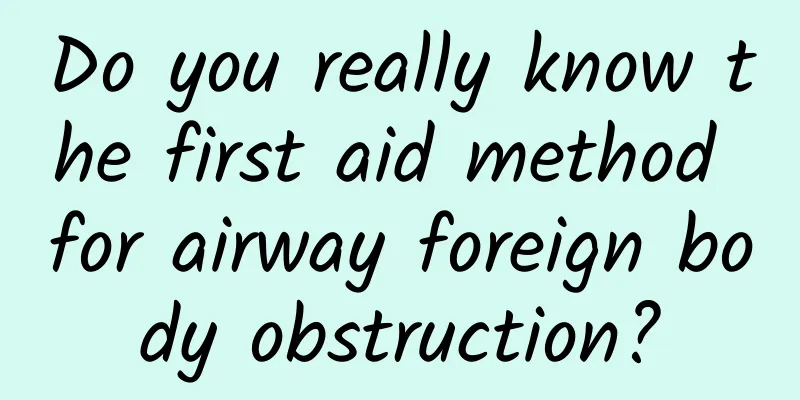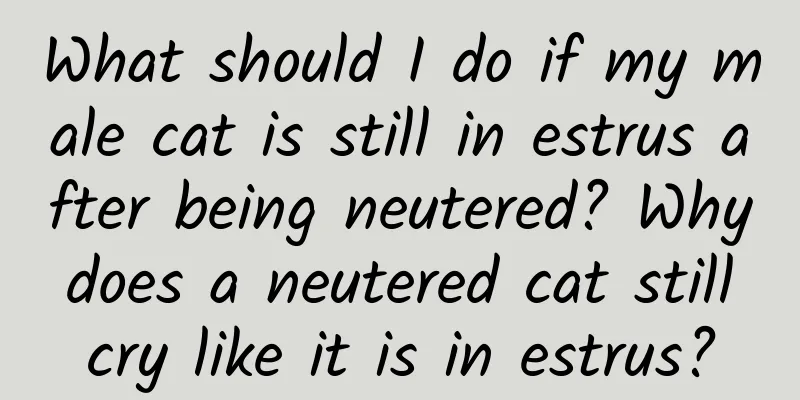Do you really know the first aid method for airway foreign body obstruction?

|
Author: Bian Yuyao, deputy chief physician of Hebei PetroChina Central Hospital Reviewer: Zhang Junwei, Chief Physician, Affiliated Hospital of North China University of Technology Duan Jun, Chief Physician, China-Japan Friendship Hospital 1. What is airway foreign body obstruction? Airway foreign body obstruction refers to foreign objects such as food blocking the trachea or bronchi, causing the patient to be unable to breathe normally or even suffocate to death. 2. How do we rescue patients with airway foreign body obstruction? You might! Figure 1 Copyright image, no permission to reprint That's possible! Figure 2 Copyright image, no permission to reprint That may be the case! Figure 3 Copyright image, no permission to reprint The Heimlich maneuver is widely used, but is the Heimlich maneuver equivalent to the airway foreign body maneuver? The "Heimlich Maneuver" is a first aid technique that was publicly published by American doctor Heimlich in 1975. The old man has been committed to promoting this technique for the rest of his life. However, in 2005, the American Heart Association (AHA) called this technique the abdominal thrust method, and the name "Heimlich Maneuver" was later changed to "abdominal thrust method". The current first aid method for airway foreign body obstruction includes three parts: back slapping method, chest thrust method and abdominal thrust method. The abdominal thrust method was invented by old man Heimlich, while the back slapping method and chest thrust method were not, so the first aid method for airway foreign body obstruction cannot be generally referred to as the "Heimlich Maneuver". 3. Who are the people at risk of airway foreign body obstruction? Infants and young children: Due to their incomplete tooth development, infants and young children have difficulty chewing hard food and are prone to inhaling objects in their mouths when eating or crying or laughing. At the same time, their epiglottis is incompletely developed, their laryngeal protective reflex is incomplete, and their coughing ability is weak. When lumps of food or other foreign objects get stuck in their throats or airways, they will be unable to breathe. Adults in special circumstances: Our human body has a special structure called "epiglottis". When we talk, the epiglottis will rise to open the laryngeal cavity; when we eat and drink, the epiglottis will cover the trachea downward to prevent foreign objects from entering the trachea. Since adults are fully developed, it is relatively rare for adults to suffocate due to airway foreign body obstruction. However, the epiglottis function of drunk people, stroke patients and other people with dysphagia will be greatly inhibited, or talking or laughing with food in the mouth can easily lead to tracheal exposure, causing food or other objects to block the airway. Elderly people: As they age, their swallowing reflex and cough reflex function decline. In addition, some elderly people suffer from cerebrovascular disease or take certain anticholinergic drugs, anti-anxiety drugs, sedatives, etc., which causes swallowing difficulties. Therefore, the elderly are prone to airway foreign body obstruction. 4. Recommended techniques for handling foreign bodies in the airway For the three operating techniques of back patting, chest impact and abdominal impact, different international organizations recommend different emphases. The following are the recommendations of several international organizations. 1. International Liaison Committee on Resuscitation (ILCOR): There is insufficient evidence to determine which method should be used first, and these 3 techniques should be used in rapid sequence until the airway obstruction is relieved. 2. European Resuscitation Council (ERC): Back impacts and abdominal impacts should be used in combination, and chest impacts should be used when necessary. 3. American Heart Association (AHA): Chest impact, back pat and abdominal impact are all feasible and effective, but in order to facilitate promotion and simplify training, abdominal impact and chest impact when necessary are recommended until the obstruction is relieved. 4. International Federation of Red Cross and Red Crescent Societies (IFRC): Back blows and abdominal or chest thrusts should be applied in rapid succession until the obstruction is cleared. Figure 4 Copyright image, no permission to reprint 5. Specific implementation of emergency treatment for foreign body obstruction of the airway (based on AHA standards) 1. Because infants and young children under 1 year old are prone to airway foreign body obstruction and have a great impact on prognosis, they are given priority in the recommended plan. For infants under 1 year old, 5 back percussions and 5 chest percussions should be performed alternately. The operation instructions are as follows: The rescuer needs to use one hand to fix the zygomatic arches and mandible on both sides of the infant (be careful not to block the child's mouth and nose), so that the face is facing down and straddling the rescuer's forearm, and support the infant with the thigh, so that the infant is in a head-down and foot-high posture. The other hand finds the middle position of the infant's shoulder blade on the back and pats it with the base of the other palm for 5 consecutive times, and pays attention to whether the child cries or groans to indicate the expulsion of the foreign body. If the foreign body is not expelled, use one hand to fix the back of the infant's skull (be careful not to damage the fontanelle), so that the face is facing up and lying on the rescuer's forearm, and support the infant with the thigh, so that the infant is in a head-down and foot-high posture. The index finger and middle finger of the other hand are together, and press inward and upward for 5 consecutive times slightly below the middle of the two nipples, and pay attention to whether the child cries or groans to indicate the expulsion of the foreign body. Use these two methods alternately until the foreign body is expelled. Figure 5 Copyright image, no permission to reprint 2. Conscious adult patients (1) Abdominal impact method: For normal-sized adult patients, the rescuer stands behind them, with one leg in front of them in a lunge position and inserted between their legs (to stabilize their body), and the other leg straightened behind them. Both hands are placed from the patient's armpits to the patient's waist, and the patient is found slightly above the navel (the AHA guidelines recommend choosing a position above the navel and far below the xiphoid process in view of the damage to the abdominal organs). One hand is clenched into a fist and placed there (the thumb is raised and pointed to the patient's xiphoid process), and the other hand is wrapped around this hand, and then the arms are suddenly tightened, and pressure is applied backwards and upwards continuously and quickly until the foreign body is expelled or the patient loses consciousness. In order to make it easier for the public to understand, you can use a more vivid memory method, that is, the "scissors, rock, paper" formula. Substitute the operation steps and you will remember it all at once. (2) Chest impact method: This method is suitable for obese people or pregnant women. The rescuer stands behind the patient (standing posture is the same as the abdominal impact method), and hugs the patient's chest with both hands from the patient's armpits to the front, with one fist placed on the lower end of the sternum, and the other hand covering this hand. Then, the rescuer suddenly tightens his arms and applies continuous and rapid pressure to the back of the chest until the foreign body is expelled. Figure 6 Copyrighted images are not authorized for reproduction (3) Back tapping method: The patient bends over into a bowing posture, and the rescuer uses the base of his palm to forcefully strike the center of the patient's back, that is, the center area between the two shoulder blades, for 5 consecutive times (this does not have to be done completely, depending on how the foreign body is coughed out). Figure 7 Copyright image is not authorized for reproduction 3. Children with reactions (over 1 year old) 5 back strikes + 5 abdominal thrusts, repeat until the foreign body is expelled, the patient can cough or breathe forcefully, or becomes unresponsive. 4. Adult patients with loss of consciousness Once the patient loses consciousness, immediately perform cardiopulmonary resuscitation and activate the emergency system to obtain an AED. It is required to check whether there is any foreign matter in the mouth after every 30 compressions and before 2 artificial respirations. If there is any foreign matter that can be removed, it should be removed in time, and then 2 artificial respirations should be performed. Repeat this cycle and continue to rescue. Be careful not to delay the compression time due to the removal of foreign matter. VI. Summary Each emergency treatment method for foreign body obstruction of the airway has its own unique advantages, but also has its own shortcomings and risks. For example, abdominal impact may cause internal organ damage, and chest impact may cause rib fracture. Only by mastering the key points of each method can the best treatment effect be achieved. |
<<: They are all mung bean soups, why are some red and some green? Which one is better?
Recommend
Can fresh black plums be eaten directly? What are the nutritional values of black plums?
Black plum is a kind of plum. People generally kn...
What are the dangers of sleeping with underwear on?
Female friends usually wear underwear, that is, b...
How to calculate ovulation period?
During the ovulation period, women must choose si...
Can I eat plums during menstruation?
The diet issue during menstruation is definitely ...
What causes dark areola color?
Breasts are very important to women. All female f...
What are the reasons for bleeding after miscarriage?
After having an abortion, women usually experienc...
Will cervical erosion cause bleeding?
Women may experience some progressive discomfort,...
Where can I buy abortion pills?
Miscarriage is generally divided into spontaneous...
What should I do if my private parts are swollen and inflamed?
In the summer, people often suffer from getting a...
Can women have facials during menstruation?
Going to a beauty salon for facial care is someth...
How to regulate women's qi and blood deficiency?
Once a woman has a problem with insufficient qi a...
How to self-check uterine recovery
We all know that women need some time to repair t...
Sudden cramping in the left lower abdomen of a woman
Women are most likely to encounter gynecological ...
Back pain after IUD insertion
Although the family planning policy has been rela...
I didn't have my period but I have leucorrhea
Every woman experiences menstruation, and it is a...









